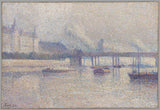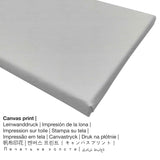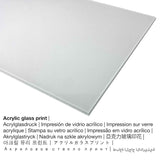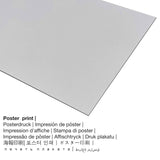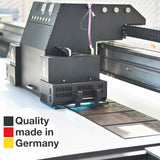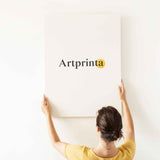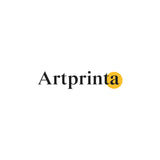Maximilien Luce, 1893 - Ogige mmiri nke Osimiri Seine dị na Paris - mbipụta nka mara mma
Ụtụ gụnyere. Mbupu gbakọrọ na ndenye ọpụpụ.
Banyere edemede a
a 19th narị afọ ihe nka mere site na French onye na-ese ihe Maximilien Luce. Ihe gafere 120 year-old original creation has the following size of unframed: 48,9 x 70,49 cm (19 1/4 x 27 3/4 in) framed: 67,63 x 88,9 x 6,67 cm (26 5/8 x 35 x 2 5/8 in). Oil on canvas was used by the artist as the technique for the painting. Besides, the work of art can be viewed in in the Ụlọ ihe ngosi nka nke Mahadum Yale nchịkọta dijitalụ. Nke nkà nke oge a ọrụ nka, nke dị na ngalaba ọha na-enye site n'ikike nke Artlọ Osisi Mahadum Yale. : Onyinye nke Helen G. Altschul, nwanyị di ya nwụrụ nke Frank Altschul, 1908, (.) 1967. Nhazi ahụ bụ odida obodo ya na oke nke 1.4: 1, nke pụtara na ogologo bụ 40% ogologo karịa obosara. The painter, lithographer Maximilien Luce was an artist, whose art style can primarily be classified as Impressionism. The French artist lived for 83 afọ A mụrụ ya na 1858 wee nwụọ na 1941.
Data nka ahaziri
| Aha eserese: | "The Banks of the Seine River in Paris" |
| Nhazi: | sere |
| Category: | nkà nke oge a |
| oge: | 19th narị afọ |
| Emepụtara n'afọ: | 1893 |
| Ogologo afọ nka nka: | karịa afọ 120 |
| Usoro nka izizi: | mmanụ na kwaaji |
| Ogo nke ọrụ nka izizi: | emebereghị: 48,9 x 70,49 cm (19 1/4 x 27 3/4 na) emebere: 67,63 x 88,9 x 6,67 cm (26 5/8 x 35 x 2 5/8 na) |
| Ụlọ ihe ngosi nka / mkpokọta: | Artlọ Osisi Mahadum Yale |
| Ebe ngosi nka: | New Haven, Connecticut, Njikota Obodo Amerika |
| Ebe nrụọrụ weebụ ihe ngosi nka: | Artlọ Osisi Mahadum Yale |
| Akwụkwọ ikike nka: | ngalaba ọha |
| Site n'aka: | Artlọ Osisi Mahadum Yale |
| kreditline ọrụ nka: | Onyinye nke Helen G. Altschul, nwanyị di ya nwụrụ nke Frank Altschul, 1908, (.) 1967 |
Onye na-ese ihe
| aha: | Maximilien Luce |
| Aha nka ndị ọzọ: | Luce Maximilien, Maximilien Luce, Luce Maximilian, Luce Maximillian, Maximilian Luce, לוק מקסמיליאן, Luce |
| okike nke onye nka: | nwoke |
| Obodo onye nka: | French |
| Ọrụ onye na-ese ihe: | onye na-ese ihe, onye na-ese ihe |
| Mba onye si: | France |
| Nhazi nke onye nka: | omenkà nke oge a |
| styles: | Mmetụta |
| Ndụ: | 83 afọ |
| Amụrụ n'afọ: | 1858 |
| Afọ ọnwụ: | 1941 |
Nye iwu ihe kacha amasị gị
Maka mbipụta nka ọ bụla, anyị na-enye nha & ihe dị iche iche. Ya mere, anyị na-enye gị ohere ịhọrọ n'ime nhọrọ ndị a:
- Mbipụta nke aluminom: Aluminium Dibond prints are prints on metal with a true depth, which creates a modern look by having a non-reflective surface. The Aluminium Dibond Print is the best start to art replicas on aluminum. For our Direct Print On Aluminum Dibond, we print the artwork right on the aluminium white-primed surface. The white and bright parts of the original artwork shimmer with a silky gloss, however without the glow. Colors are luminous, fine details of the print are clear and crisp. This print on aluminium is one of the most demanded entry-level products and is a stylish way to display fine art reproductions, because it puts all of the viewer’s focus on the artwork.
- Kwaaji: The printed canvas, not to be confused with a real artwork painted on a canvas, is a digital copy applied onto cotton canvas material. A printed canvas of your favorite work of art will allow you to transform your into a large artpiece like you would see in a gallery. The great advantage of canvas prints is that they are relatively low in weight, meaning that it is quite simple to hang up the Canvas print without the help of any wall-mounts. Canvas prints are suited for any kind of wall.
- Poster (akwa akwa akwa): Our poster is a UV printed flat canvas paper with a slight texture on the surface. It is optimally suited for putting your art copy with a special frame. Please keep in mind, that depending on the absolute size of the canvas poster print we add a white margin 2-6cm round about the print motif in order to facilitate the framing with your custom frame.
- Mbipụta iko acrylic (nke nwere ezigbo mkpuchi iko): A glossy print on acrylic glass, often denoted as a fine art print on plexiglass, changes your favorite original artwork into beautiful wall decoration. What is more, the acrylic glass art print makes a great alternative to dibond or canvas fine art replicas. With a glossy acrylic glass art print contrasts and also details become more visible due to the subtle tonal gradation in the picture.
Banyere ihe
| Nkewa edemede: | ezi nka mmeputakwa |
| Mmeputakwa: | dijitalụ mmeputakwa |
| Usoro mmepụta: | mbipụta dijitalụ |
| Mmalite nke ngwaahịa a: | Germany |
| Ụdị ngwaahịa: | mmepụta ihe na-achọ |
| Ojiji ngwaahịa: | mgbidi mgbidi, ime ụlọ |
| Nhazi onyonyo: | usoro odida obodo |
| Ụdị anya: | 1.4:1- ogologo: obosara |
| Mmetụta akụkụ: | ogologo bụ 40% ogologo karịa obosara |
| Ụdị dị iche iche dị: | Mbipụta kwaaji, mbipụta enyo acrylic (nwere ezigbo mkpuchi iko), mbipụta ọla (aluminium dibond), mbipụta akwụkwọ mmado (akwụkwọ kwaaji) |
| Kanvas n'elu etiti ihe ndọtị (mbipụta akwa akwa): | 70x50cm - 28x20", 140x100cm - 55x39" |
| Mbipụta iko acrylic (nwere ezigbo mkpuchi iko) dị iche iche: | 70x50cm - 28x20", 140x100cm - 55x39" |
| Mpempe akwụkwọ mmado (akwụkwọ kwaaji) nha dị iche iche: | 70x50cm - 28x20" |
| Ụdị mbipụta aluminom: | 70x50cm - 28x20", 140x100cm - 55x39" |
| Igwe onyonyo: | adịghị |
Ihe dị mkpa: We try to describe the art products with as many details as we can and to illustrate them visually. Still, the colors of the print products, as well as the printing might diverge to a certain extent from the representation on the device's screen. Depending on the settings of your screen and the quality of the surface, color pigments can unfortunately not be printed 100% realistically. Since our are processed and printed by hand, there might as well be minor deviations in the motif's size and exact position.
© Nwebiisinka nke, Artprinta (www.artprinta.com)

